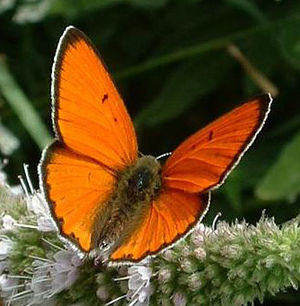Lycaeninae
| Lycaeninae | ||||||||||||
|---|---|---|---|---|---|---|---|---|---|---|---|---|

Great fire butterfly ( Lycaena dispar ), ♂ |
||||||||||||
| Systematics | ||||||||||||
|
||||||||||||
| Scientific name | ||||||||||||
| Lycaeninae | ||||||||||||
| Leach , 1815 |
The Lycaeninae are a very large subfamily of the bluebells (Lycaenidae). They occur world-wide with about 4000 kinds in 500 genera and thus contain two thirds of all kinds of blueing. Some of the subfamilies used earlier, such as the Polyommantinae or Theclinae, were incorporated as tribe within the Lycaeninae. In Europe, 136 species are endemic, 58 of which also come in Central Europe before.
features
The assumed autapomorphies that characterize the subfamilies are the small "tails" present in many species as extensions of the wing vein CuA2. Although this feature is missing in some species, the close relationship to the tailed species is undisputed. In the rest position of some species, the hind wings are moved in a circular motion, which, in combination with the tails, is intended to induce predators to attack this supposed head of the animals. Some species of Charaxinae (about Charaxes jasius ) and riodinidae (Riodininae) move their hind wings, too, but the movements are different from those of lycaeninae.
The caterpillars have glands that can secrete honeydew . The species of the tribe Lycaenini and Theclini do not have these, but it is assumed that they were regressed over time.
Way of life
The caterpillars of the Lycaeninae feed on a very wide range of food plants, many of them belong to the subclass of the rose-like (Rosidae). In addition, there are a number of species that, at least in some developmental steps, feed on predatory food , for example plant lice . Many live myrmekophil with or from ants or their brood. There are a number of species that occur as pests on flowers, fruits or seeds, such as the blue pelargonium ( Cacyreus marshalli ) introduced into Europe .
supporting documents
Individual evidence
- ↑ Lycaeninae in Fauna Europaea. Retrieved February 28, 2011
- ↑ Lycaenidae. Lepiforum eV, accessed December 30, 2007 .
literature
- NP Kristensen: Lepidoptera, Moths and Butterflies, 1: Evolution, Systematics, and Biogeography. Handbuch der Zoologie 4 (35) p. 285, Walter de Gruyter. Berlin, New York 2003, ISBN 3-11-015704-7